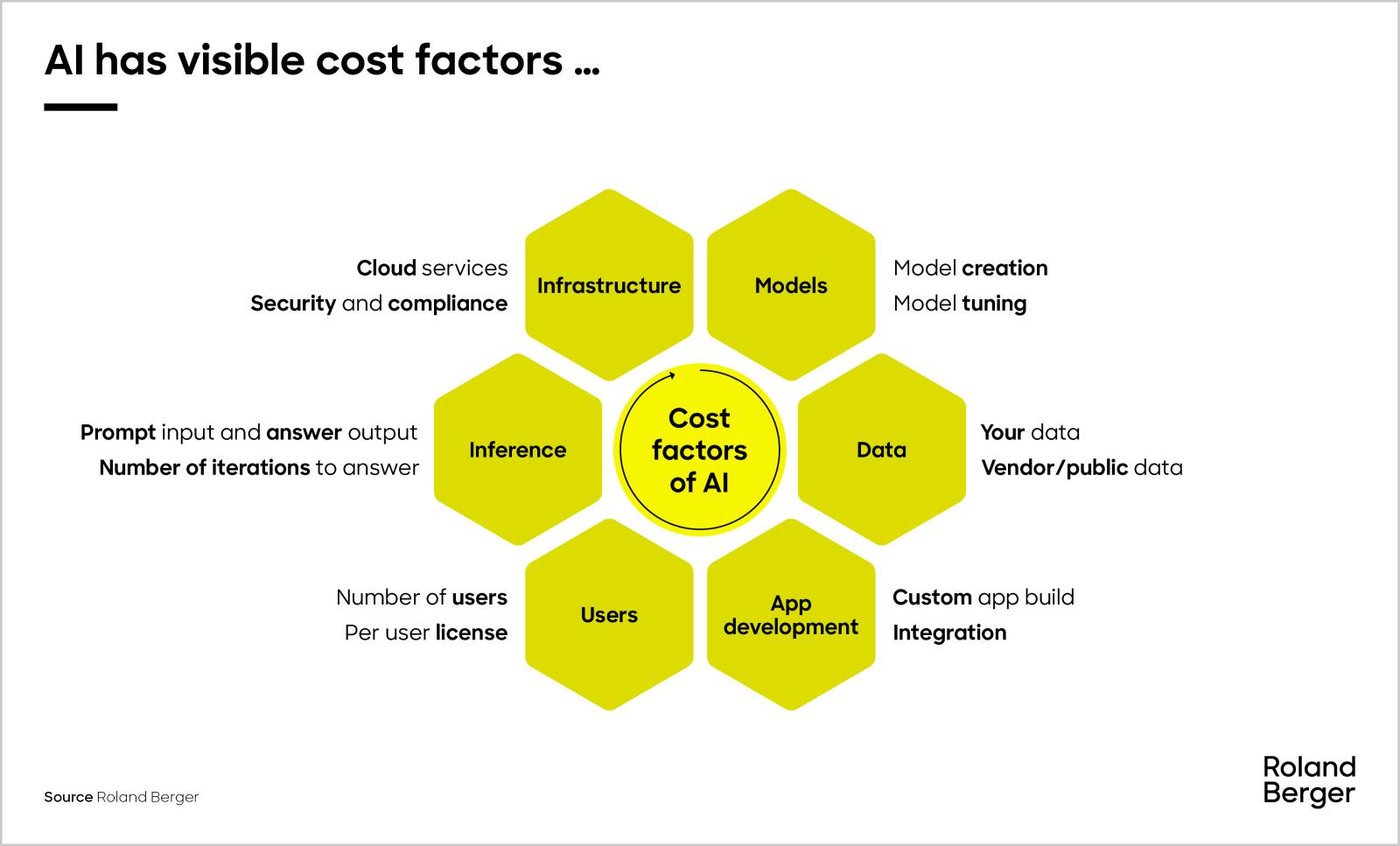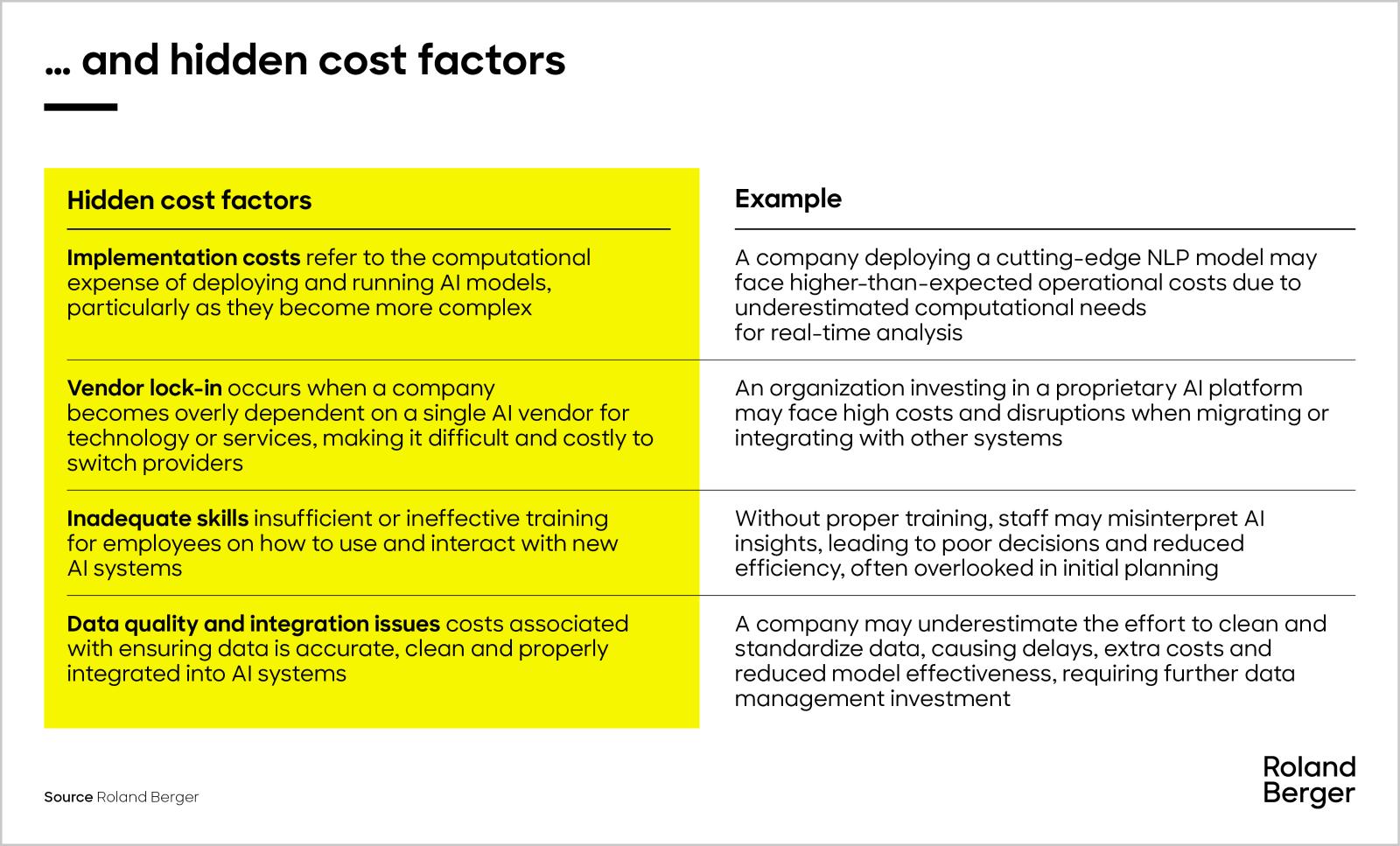Generative AI is transforming information technology functions across the Middle East. We look at the challenges and opportunities of GenAI.


Measuring the cost of AI projects in the Middle East: A comprehensive analysis
Building smarter financial models for successful AI transformation
Implementing artificial intelligence (AI) solutions in the Middle Easter presents significant financial challenges, requiring meticulous advance planning and assessment. According to recent research conducted by Roland Berger, the cost of such projects frequently exceeds initial projections by 500-1,000%. The result? Over half of AI initiatives in the region are terminated due to budget overruns. In this article, we examine the visible and invisible costs of AI implementation in the Middle Eastern context and make recommendations for how companies can ensure comprehensive financial projections.

AI investment in the Middle East
The Middle Eastern AI market has substantial growth potential, with projections indicating a valuation of USD 320 billion by 2030. However, the regional context is a complex one. Of the numerous challenges companies face, financial management is a major factor contributing to executive dissatisfaction with AI projects, second only to insufficient access to qualified personnel.
Notably, our research shows that less than 15% of organizations properly identify, quantify and measure the costs, risks and value associated with their AI projects. This lack of rigorous financial planning results in many projects failing during implementation and a sub-optimal return on investment (RoI) across the region.

Visible and invisible cost components
AI projects in the Middle East have both visible, quantifiable cost components and concealed cost elements specific to the geographical region. When establishing budgetary parameters for AI initiatives, organizations typically account for the following visible cost components:
Data acquisition and management: Internal data preparation, standardization and governance procedures, and the procurement of external or public datasets from specialized vendors
Model development and implementation: Both the initial architecture design and model creation, and any subsequent refinement and optimization procedures
Application development and integration: Custom software development requirements, system integration with existing technological infrastructure, cloud service implementation and management, as well as security protocol establishment and compliance verification
Operational expenditure: Infrastructure maintenance and enhancement, licensing fees calculated on a per-user basis, computational costs associated with inference (prompt processing and response generation), and processing iterations required for optimal output generation
However, organizations frequently neglect to take into account sufficiently the hidden cost components or unforeseen expenditures arising in projects in the Middle Eastern context:
Implementation complexity factors: Organizations implementing Arabic Natural Language Processing (NLP) capabilities often encounter substantially higher computational requirements due to dialectical variations and linguistic complexities. Real-time analysis capabilities frequently necessitate more substantial computational resources than initially projected
Data quality and integration: The technological infrastructure in the region is characterized by fragmentation and often outdated systems. The data preprocessing and standardization requirements in AI projects frequently exceed the initial resource allocations, and cross-system integration creates additional unforeseen expenditures
Regional adaptation: AI solutions developed for global markets frequently require substantial modification to accommodate regional specificities. Models trained predominantly on Western datasets must be significantly recalibrated for Middle Eastern implementation
Infrastructure limitations: Despite substantial investment in technological infrastructure (such as Saudi Arabia's USD 15 billion commitment to developing data centers by 2030), the region still suffers from deficiencies in cloud computing capabilities and computational infrastructure. As a result, organizations frequently have to develop more robust infrastructure than initially anticipated
Human capital acquisition and retention: The competitive market conditions for AI expertise in the region significantly increase the personnel-related costs. Organizations based in the United Arab Emirates (UAE), for example, predominantly rely on expatriate talent, resulting in elevated compensation requirements and associated onboarding expenditure
Regulatory compliance: Data sovereignty regulations mandating the local storage of sensitive information increase operational costs, particularly in highly regulated sectors such as healthcare and financial services. In addition, the evolving nature of regulatory frameworks necessitates ongoing investment to maintain compliance standards
Vendor dependency: Organizations that are reliant specific AI vendors encounter substantial costs when trying to switch to alternative solutions or integrate additional systems. The financial implications of such vendor transitions are frequently underestimated during initial project planning
Competency development: Inadequate training for the personnel using AI systems results in operational inefficiencies and suboptimal decision-making. Training initiatives frequently require expansion beyond the initial projections
"AI has the potential to transform the Middle East’s economy—but without accurate cost modelling and region-specific planning, even the most promising projects risk falling short."
Classifying AI initiatives
To avoid underestimating costs, we advise organizations to develop a robust financial model at the outset of the AI implementation initiative. Underlying this is a classification of projects based on their intended organizational impact.
The first category of projects is task-specific enhancement initiatives, or AI projects focused on maintaining the company's competitiveness. These are projects designed to achieve incremental efficiency improvements, predictive maintenance capabilities and fundamental process automation. They require disciplined cost management but typically involve fewer unforeseen expenditures.
The second group are projects involving process optimization for competitive differentiation. Here, the company uses AI to expand their market presence, customer reach and revenue generation. Projects are generally focused on experience personalization, pricing optimization or supply chain enhancement. These initiatives frequently encounter substantial regional adaptation costs.
Finally, we have transformative strategic initiatives, where AI is used to establish new products, markets or core operational processes. These projects fundamentally reconfigure the business model and competitive dynamics. They are comprehensive undertakings that frequently encounter the full spectrum of hidden costs.
Five strategic recommendations
To make their AI project cost estimations more accurate, we recommend that organizations operating in the Middle East take the following five strategic steps:
- Conduct a comprehensive technical assessment
First, the organization should develop a detailed understanding of the specific algorithms, machine-learning (ML) models and neural networks required for implementation. Importantly, they should evaluate the computational requirements under realistic operating conditions. - Perform a methodical data analysis
Next, it is necessary to assess the scope, volume and quality of the available data resources, allocating substantial resources to data standardization and preparation and evaluating the integration requirements across existing technological systems - Implement rigorous risk assessment procedures
The third step is to identify any potential risks and uncertainties specific to the Middle Eastern operational context and develop contingency strategies with associated budgetary allocations. - Project return on investment (RoI) accurately
The task here is to establish equilibrium between project expenditure and anticipated organizational benefits. Importantly, the organization should take into account any extended implementation timelines compared to global benchmarks. - Establish robust financial management protocols
Finally, we strongly recommend developing detailed budgetary allocations across all the project implementation phases. These allocations should include substantial contingency provisions for unforeseen expenditure









